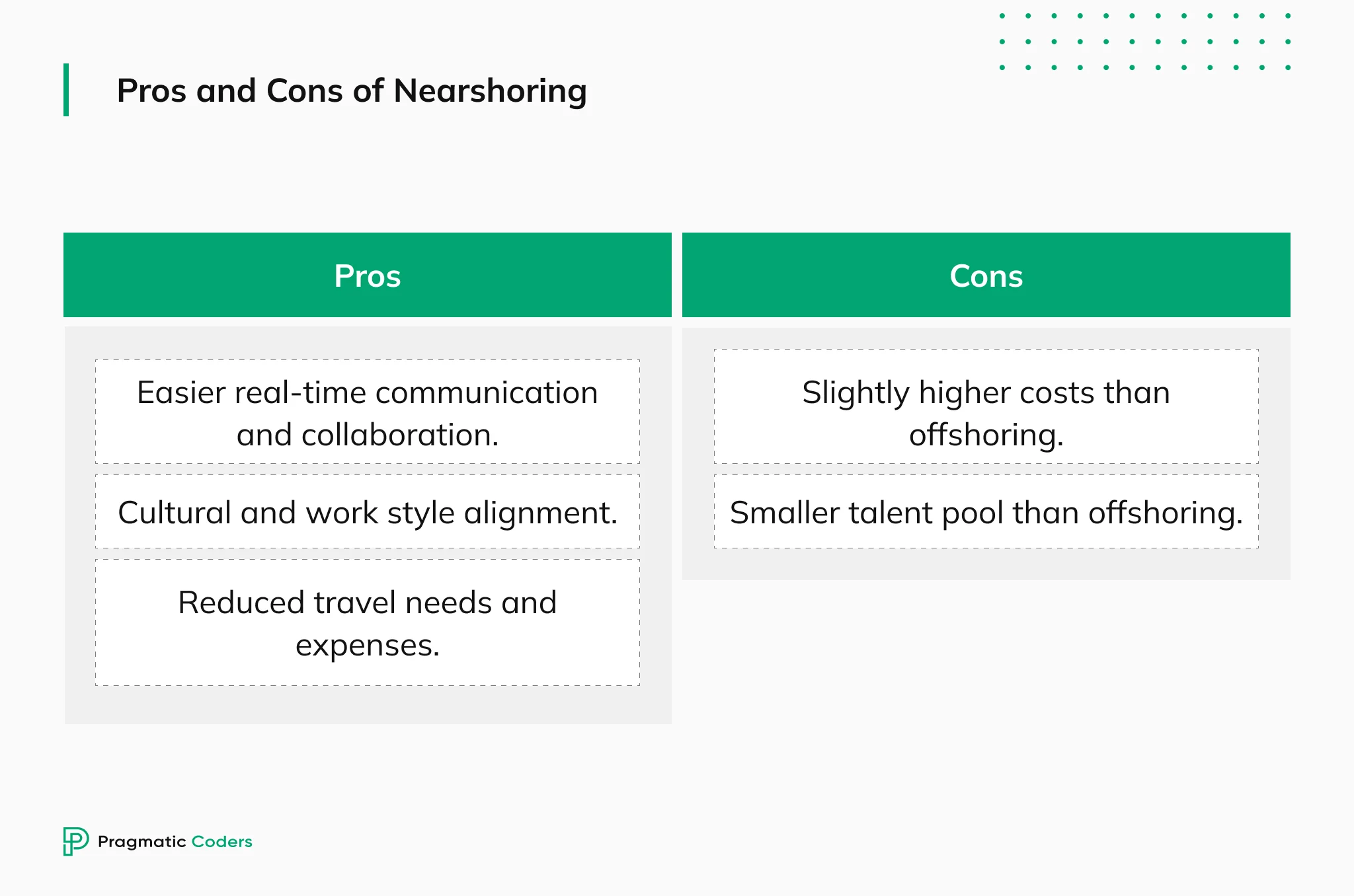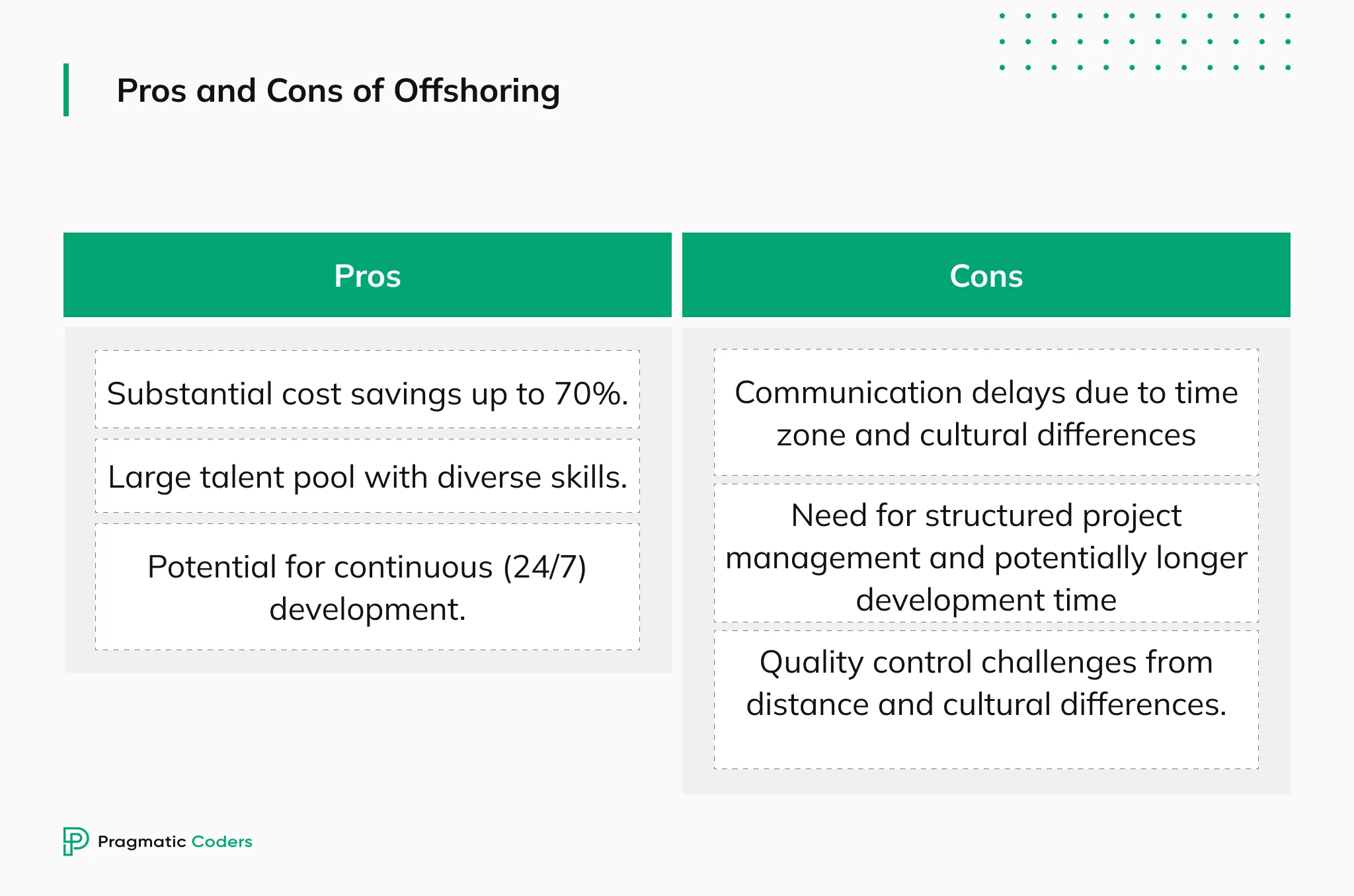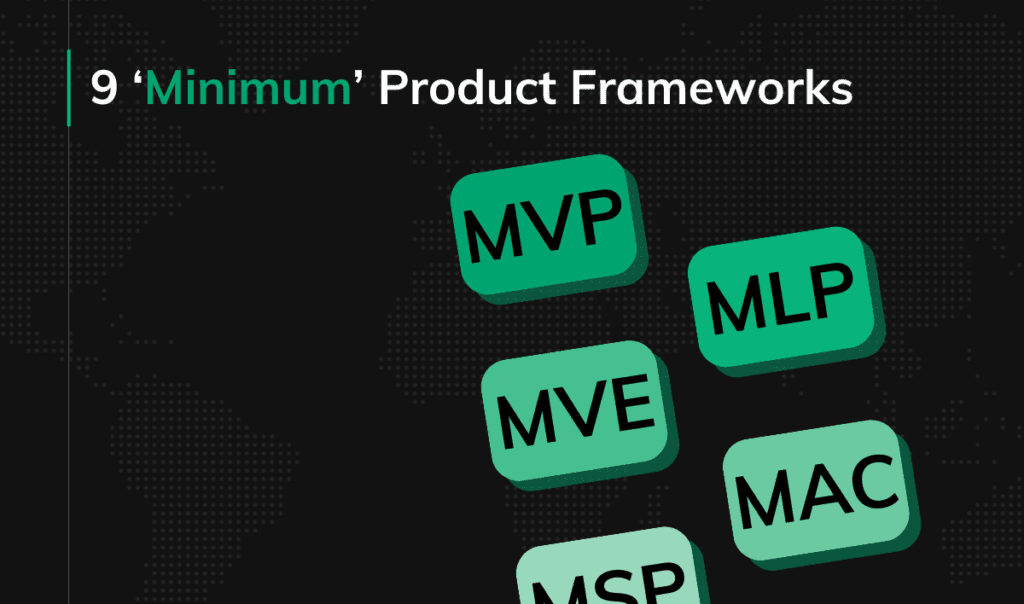Nearshore vs Offshore in 2024: comparing software outsourcing models

In today’s fast-paced tech landscape, staying innovative is crucial. Yet, building and maintaining a robust in-house development team can be challenging, especially for startups or companies facing specific skill shortages. This is where software outsourcing becomes valuable.
Software outsourcing involves hiring an external, qualified team to develop or maintain your digital products. It provides access to a broader talent pool, reduces development costs, and allows your internal team to concentrate on core business activities. This approach is a popular option among businesses of all sizes. According to recent studies, the revenue in the IT outsourcing market is projected to reach $512.50 billion in 2024.Software outsourcing comes in two main flavors: nearshore and offshore. Nearshore outsourcing partners you with a software team in a geographically nearby country, benefiting from similar time zones. Offshore outsourcing, on the other hand, involves working with a team in a far-off country, which often leads to significant time zone differences.
The choice between nearshore and offshore outsourcing depends on your project’s specific needs and priorities. This guide will explain the key differences between nearshore and offshore development outsourcing, helping you choose the right outsourcing option. After you’ve decided, refer to this guide for detailed instructions on hiring offshore developers.
Tl;dr
Quick overview of Nearshore and Offshore software development outsourcing
|
Key differences between nearshore vs offshore development outsourcing
The decision between nearshore and offshore outsourcing hinges on several crucial factors. Let’s delve into the key aspects that differentiate these two models:
Geographical proximity and time zones
Nearshore countries offer a significant advantage in terms of location and time zones. Working with nearshore developers means minimal time zone differences, often within a few hours. This facilitates easier communication, real-time collaboration, and quicker response times. For example, a US company collaborating with a nearshore partner from Canada can easily schedule overlapping meetings. They have clear, uninterrupted communication throughout the workday.
In contrast, offshore companies are usually located in time zones that are several hours away, for example, India is ~10 hours ahead of New York. This can cause communication delays, scheduling difficulties, and a reliance on asynchronous communication tools like emails, text apps, and project management platforms.
Cost differences between nearshoring and offshoring
Cost is a major factor for many companies considering outsourcing. Offshore software development generally offers the most significant cost savings. Regions like India, Eastern and Central Europe, and Southeast Asia boast large talent pools with competitive developer rates. This can be particularly attractive for businesses with tight budgets or projects requiring a large development team.
However, it’s important to consider the hidden costs associated with offshore outsourcing. These can include expenses for communication tools like video conferencing software and potential travel costs for onsite meetings. Additionally, managing an offshore software development team can present challenges due to significant time zone and cultural differences.
Nearshore outsourcing typically falls between onshore and offshore costs. While it may be slightly more expensive than offshoring, nearshore teams often offer better communication and cultural alignment. This potentially leads to fewer project delays and a smoother business process in general.
Cultural alignment of software development teams
Cultural similarities are key to successful nearshore or offshore collaboration. When working with nearshore companies, you’re more likely to find similar work styles, communication habits, and business practices. This similarity can make project management easier, reduce misunderstandings, and help build a stronger working relationship.
For instance, a US company outsourcing to a nearby country like Canada is less likely to face cultural barriers, especially when compared to working with an offshore partner from Asia. Shared cultural norms and business etiquette can streamline communication and make decision-making processes more efficient.
Offshore teams may operate with different communication styles, work ethics, and business practices. This can necessitate adjustments in communication approaches. A more hands-on management style ensures project alignment and quality control in such cases.
Interestingly, Poland has become a popular offshore development center for US companies, thanks to its growing pool of skilled developers and a work culture that aligns closely with the US. Despite some remaining formalities in Polish business culture, there’s an increasing focus on direct communication, efficiency, and results. These shared values mesh well with American work styles, reducing communication issues and fostering a more productive working relationship.
Talent pool and expertise
The size and expertise of the available talent pool can vary depending on your chosen outsourcing destination. Offshore locations like Poland offer a vast pool of skilled developers across various disciplines. This can be beneficial for finding specialists in specific programming languages or niche technologies.
Nearshore locations may have a smaller talent pool compared to some offshore destinations. However, nearshore teams often boast strong skills in technologies relevant to your target market. Additionally, language barriers are less likely to be an issue, potentially leading to smoother project execution.
Pros and cons of nearshore software development outsourcing
Nearshore outsourcing offers a compelling middle ground between the cost benefits of offshore software development and the smooth collaboration of onshore teams. Here’s a breakdown of the key advantages and disadvantages to consider when making your decision:
Advantages of nearshore outsourcing
Seamless Communication and Collaboration: Nearshore software development teams typically operate within a few hours of your time zone. This overlap allows for real-time communication, quick response times, and easier scheduling of meetings and calls. Imagine a West Coast company partnering with a nearshore team in Costa Rica. With a one-hour time difference, they can easily conduct daily stand-up meetings. They collaborate on projects throughout the workday without any significant communication lags. This fosters a more dynamic and efficient workflow compared to significant time zone gaps encountered in offshore outsourcing.
Cultural Alignment and Shared Work Styles: Cultural similarities can significantly improve project outcomes. Working with a nearshore team often means encountering similar work styles, communication preferences, and business practices. This reduces misunderstandings, simplifies project management, and fosters a more cohesive working relationship. For example, a US company outsourcing development of a project management tool to a nearshore team in Canada benefits from shared cultural norms. These include professionalism, direct communication, and meeting deadlines. This cultural alignment can lead to a smoother project flow and a higher quality final product.
Reduced Travel Needs: Nearshore locations, being geographically closer, can reduce the need for frequent travel for project oversight or in-person meetings. This leads to savings on travel expenses, allowing your internal team to focus on core business functions without constant interruptions

Disadvantages of nearshore outsourcing
Higher Costs Compared to Offshore: While still more affordable than onshore development, nearshore outsourcing often costs a bit more than offshore options. This is because developer rates in nearshore regions are competitive, but not as low as those in offshore areas.
Smaller Talent Pool: The talent pool in nearshore locations may be smaller than in large offshore destinations like India, which might be challenging for projects needing niche skills. However, nearshore teams often have strong expertise in technologies important to your market, which can make up for the smaller talent pool.
Pros and cons of offshore software development outsourcing
Offshore outsourcing typically provides the biggest cost savings compared to nearshore and onshore options. This makes it a great choice for startups, companies on tight budgets, or projects needing a large team. However, it’s important to weigh both the pros and cons before choosing offshore development services.
Advantages of offshore outsourcing
Dramatic Cost Savings: The primary advantage of offshore outsourcing is the substantial cost savings it offers. Locations like India, Eastern and Central Europe, and Southeast Asia boast large pools of skilled developers with competitive rates. A study by Clutch Group found that companies can achieve cost reductions of up to 70% by outsourcing development tasks offshore. This allows businesses to stretch their budgets further, invest in other areas, and potentially gain a competitive edge through faster development cycles.
Vast Talent Pool and Diverse Skillsets: Offshore locations often offer a vast talent pool, including developers skilled in a wide range of programming languages and technologies. This is especially useful for projects needing specific skills that may be scarce domestically. For example, a company developing a complex data analytics platform could tap into a large number of data science specialists in offshore places like Poland or the Philippines.
Potential for 24/7 Development Cycles: The significant time zone differences between your company and an offshore team can work to your advantage, allowing for a near-24/7 development cycle. As your team sleeps, the offshore team can keep working on the project, potentially leading to faster turnaround times. This can be especially beneficial for global businesses or those with tight project deadlines. It’s very hard to coordinate and may lead to a number of problems, however.

Disadvantages of offshore outsourcing
Communication Challenges: Time zone differences and cultural barriers often lead to communication challenges in offshore outsourcing, including delayed responses and misunderstandings from cultural nuances. These issues can cause project delays and require extra work. To overcome these challenges, companies may need to invest in strong communication tools, ensure clear project documentation, and possibly take a more hands-on approach to management.
Increased Project Management Needs: Effectively managing an offshore team calls for a structured project management approach. Companies might have to invest in project management software, set up clear communication protocols, and consider assigning a dedicated project manager to oversee the offshore team’s work. While this extra management layer can complicate things and might increase project costs, it’s crucial for smooth operations.
Potential Quality Control Issues: Geographical distance and cultural differences can make quality control more challenging in offshore development. It’s crucial to clearly communicate project requirements and have experienced product managers. Implementing well-defined testing procedures and frequent code reviews becomes essential. This is why value-oriented agile companies, like Pragmatic Coders, are highly valued as offshoring partners.
Offshore vs Nearshore: choosing the right outsourcing model for your needs
Now that you’re familiar with the pros and cons of both nearshore and offshore outsourcing, it’s time to pick the model that fits your project needs best. Consider these factors when choosing your outsourcing partner:
- Project Complexity and Budget: Offshore development is appealing for simple projects with tight budgets due to its cost savings. However, nearshore outsourcing might be a better fit for complex projects requiring detailed functionalities or close collaboration, thanks to easier communication and cultural alignment.
- Need for Real-Time Collaboration and Cultural Fit: Nearshore outsourcing is preferable if real-time communication, swift responses, and a shared cultural background are vital for your project. This is especially important for projects that need constant client feedback or frequent design changes.
- Project’s Specialized Skill Requirements: For projects needing specific skills in niche technologies, you might need to look at both nearshore and offshore options. Offshore locations typically offer a broader selection of developers, while nearshore teams may have a better grasp of technologies relevant to your market.
- Your Experience Managing Remote Teams: Managing remote teams effectively requires good communication, solid project management practices, and established workflows. If your company is new to remote team management, nearshore outsourcing might be less risky due to the simpler communication. Alternatively, choosing a company that can build and manage an offshore team for you, following the Build-Operate-Transfer model, could be another route.
Conclusion
Nearshore and offshore outsourcing offer distinct advantages and disadvantages. The key to success lies in choosing the model that best complements your specific project needs and company culture.
Ultimately, the best outsourcing model depends on your priorities. By carefully considering the factors outlined above, you can make an informed decision that empowers your team to achieve successful project outcomes.







